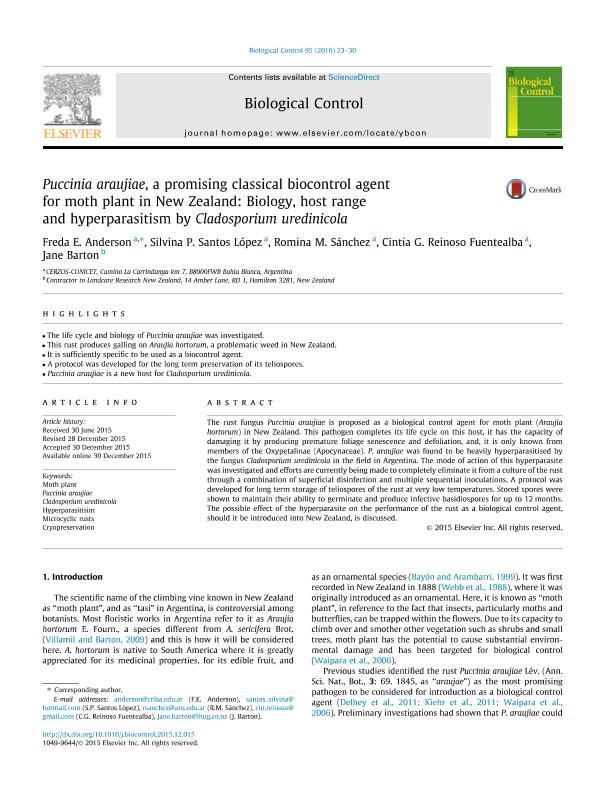Artículo
Puccinia araujae, a promising classical biocontrol agent for moth plant in New Zealand: Biology, host range and hyperparasitism by Cladosporium uredinicola
Anderson, Freda Elizabeth ; Santos López, Silvina Paola
; Santos López, Silvina Paola ; Sanchez, Romina Magali
; Sanchez, Romina Magali ; Reinoso Fuentealba, Cintia Gabriela
; Reinoso Fuentealba, Cintia Gabriela ; Barton, Jane
; Barton, Jane
 ; Santos López, Silvina Paola
; Santos López, Silvina Paola ; Sanchez, Romina Magali
; Sanchez, Romina Magali ; Reinoso Fuentealba, Cintia Gabriela
; Reinoso Fuentealba, Cintia Gabriela ; Barton, Jane
; Barton, Jane
Fecha de publicación:
04/2016
Editorial:
Elsevier
Revista:
Biological Control
ISSN:
1049-9644
Idioma:
Inglés
Tipo de recurso:
Artículo publicado
Clasificación temática:
Resumen
The rust fungusPuccinia araujiaeis proposed as a biological control agent for moth plant (Araujiahortorum) in New Zealand. This pathogen completes its life cycle on this host, it has the capacity ofdamaging it by producing premature foliage senescence and defoliation, and, it is only known frommembers of the Oxypetalinae (Apocynaceae).P. araujiaewas found to be heavily hyperparasitised bythe fungusCladosporium uredinicolain the field in Argentina. The mode of action of this hyperparasitewas investigated and efforts are currently being made to completely eliminate it from a culture of the rustthrough a combination of superficial disinfection and multiple sequential inoculations. A protocol wasdeveloped for long term storage of teliospores of the rust at very low temperatures. Stored spores wereshown to maintain their ability to germinate and produce infective basidiospores for up to 12 months.The possible effect of the hyperparasite on the performance of the rust as a biological control agent,should it be introduced into New Zealand, is discussed.
Archivos asociados
Licencia
Identificadores
Colecciones
Articulos(CERZOS)
Articulos de CENTRO REC.NAT.RENOVABLES DE ZONA SEMIARIDA(I)
Articulos de CENTRO REC.NAT.RENOVABLES DE ZONA SEMIARIDA(I)
Citación
Anderson, Freda Elizabeth; Santos López, Silvina Paola; Sanchez, Romina Magali; Reinoso Fuentealba, Cintia Gabriela; Barton, Jane; Puccinia araujae, a promising classical biocontrol agent for moth plant in New Zealand: Biology, host range and hyperparasitism by Cladosporium uredinicola; Elsevier; Biological Control; 95; 4-2016; 23-30
Compartir
Altmétricas



